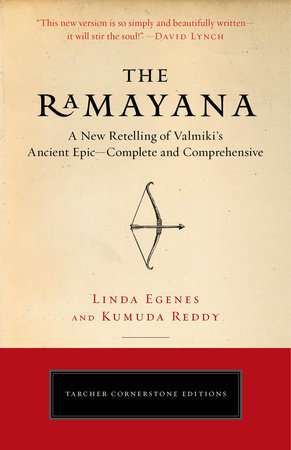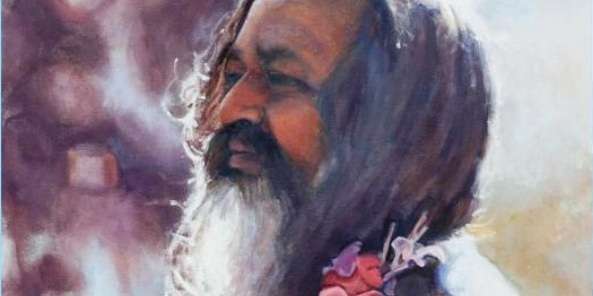Linda Egenes and Dr. Kumuda Reddy are both celebrated and prolific writers on Transcendental Meditation, health and wellness. This time, the two authors have joined their brilliant minds for a capturing retelling in prose of the ancient epic The Ramayana: A New Retelling of Valmiki’s Ancient Epic—Complete and Comprehensive (TarcherPerigee). We asked them how and why their new masterpiece, which makes the timeless story accessible to modern readers, was born.
 While there are endless layers to The Ramayana in terms of the ethical teaching or spiritual guidance one can derive from this ancient epic story, what was it for you personally that stirred you the most to undertake writing its retelling?
While there are endless layers to The Ramayana in terms of the ethical teaching or spiritual guidance one can derive from this ancient epic story, what was it for you personally that stirred you the most to undertake writing its retelling?
Dr. Kumuda Reddy: The Ramayana is a story that is beyond time. Every individual, family and society experiences problems with relationships, children, work and so forth that are not so different from one era to the other. The source of all these problems also never changes with the times—it is creating imbalances in the body, mind, emotions, behavior and environment by violating natural law.
In The Ramayana one can find most highly evolved personalities such as Rama, Sita, Hanuman and many others who are rooted in truth and Dharma, natural law, in their thoughts, speech and actions under all circumstances. To encounter such people is to come face to face with life. It’s like standing in front of a mirror and seeing for the first time who you really are and what is your life in the context of values, lasting peace and happiness.
The Ramayana will stir your soul and gently and effortlessly bring about these needed changes and values. It will teach in the subtlest way how to foster and enjoy good relationships with friends, parents, spouses and children, your associates and workers and all of the nature around you.
Linda Egenes: I have to admit, it was the love story of Rama and Sita that first attracted me to the epic. Before we were married, my husband, Tom Egenes, who is a Sanskrit professor, told me lots of stories from The Ramayana, how Rama and Sita were so devoted to each other and how she followed him to the forest when he was banished from the kingdom. So of course I had to read it myself.
I was struck by its spiritual depth. Here was a story about an enlightened hero and heroine who faced human challenges of loss of wealth, betrayal, and separation from loved ones. They were pressed to their limits. The fact that they could endure these challenges while still treating each person and creature they met with dignity, respect and compassion was such a moving lesson for me. Forgiveness, perseverance and compassion are all important themes in The Ramayana.
As you read The Ramayana, you can’t help but absorb the spiritual wisdom. You’re just enjoying the story and then you find yourself transcending to these profound levels of truth.
For a Western person reading The Ramayana, one of the most confusing aspects is the conflict between personal desire and societal duty. For example, we have a very different understanding of what constitutes breach of duty and what is allowed in pursuit of personal happiness in family relationships (e.g. getting a divorce to marry someone else to be happier). In The Ramayana, it is the characters who do what they think will make them happy in spite of what is their duty that bring destruction upon themselves.
Yet, in our modern societies we lack clear rules determining what the right conduct is regarding so many aspects of our lives. So how can we know what is the right thing to do?
Dr. Kumuda Reddy: In The Ramayana you see that people enjoying higher states of consciousness are able to make right decisions for the good of all. When one is more evolved, one rises over petty ego and self-centeredness, and understands that happiness lies in helping others.
Right and wrong becomes clear when the mind is clear. When the mind is clear and the brain is more conscious, you find it effortless to make right choices. Transcendental Meditation helps in this aspect by reducing and eliminating the stresses and strain of life from the mind.
Linda Egenes: This question delves into the heart of The Ramayana. The major theme is dharma, which could be defined as right action, action in accord with natural law, with nature itself. In everyday life, this means living in a way that upholds the path of evolution, success, and balance for yourself and everyone around you. Rama is the embodiment of dharma in every situation. Whether he is in the role of son, brother, husband, student, ruler, warrior, disciple, friend or enemy, he acts in a way that uplifts and transforms the people around him and helps them to evolve.
Yet, as in real life, he is confronted with many conflicts in dharma. Which is more important, his dharma as a ruler or his dharma as a husband? Should he allow himself to be banished to the forest to uphold his father’s promise, staying true to his dharma as a son, or should he return to rule the kingdom, as his brother Bharata and all the people of the kingdom beg him to do?
There is a major difference between East and West. In eastern cultures, individual rights and needs are considered less important than those of society. In the West, and especially here in America, we are taught to put individual rights and needs above those of society’s. So this is a difference in perspective that can be confusing to Western readers. When reading The Ramayana, we Westerners have to take a shift in perspective and see things in terms of the greater good. I have found this expanded viewpoint has helped me to resolve conflicts in dharma in my own life.
You both have written great books and articles before on Ayurveda and Transcendental Meditation and undertaken also projects such as The Ramayana – retelling great ancient stories of India. What is the difference between writing from scratch as opposed to retelling a story? What are the conditions for you as writers to be able to harness the focus and creativity needed to write in such an eloquent and captivating manner as you have—both in the case of The Ramayana and your other books?
Dr. Kumuda Reddy: It’s about passion for something. For me it was medicine, which I enjoy very much. I started with Western medicine and ended up with Maharishi Ayurveda to fulfill the need of time and to answer the many missing elements of Western medicine. Eventually in my practice I aimed to integrate the two to help a person under all circumstances, ranging from prevention to crises.
For me, writing is the expression of this passion. But my interests are not limited to medicine alone. All of life—the totality of life and the wholeness of who we really are—led to my practice of the Transcendental Meditation technique, the quest of self-realization, and my desire to bring this higher knowledge to others as well.
Linda Egenes: While it helped to have the story already plotted out, we were taking a work that is four or five times longer and condensing it to a length that the modern reader would find accessible. So there were many decisions to determine what to leave out and what to keep in. We decided to leave out the long side stories and preserve the main narrative structure of Rama’s journey.
Even though we employed modern narrative techniques in telling the story, our main focus was to retain the delicate feeling level and wisdom of the original epic. We wanted to convey all the spiritual depth and sweetness of the original, while making it easy to read.
As for what is different about collaborating on retelling The Ramayana and writing my own stories, I think the main difference is the sacred nature of the epic.
First of all, it is a humbling experience to even attempt to retell the most widely read epic in history, which is a spiritual guide to over a billion Indians today. I took this endeavor very seriously, and before each writing session, I would make sure that I was rested, that I spent enough time to do my full Transcendental Meditation program, that I ate foods that would give me a clear mind. I wanted to write from a settled mind and a flowing heart, and I relied on my twice-daily Transcendental Meditation practice to help me with that.
It was a very joyful, focused and evolutionary time, working on this manuscript. I felt that I was transformed, and I feel honored and grateful to have had this opportunity. I especially want to thank my co-author, Dr. Reddy, who had the inspiration to do this work and asked me to join her.

Speaking of Transcendental Meditation (TM), how specifically does this practice help you write better?
Linda Egenes: I don’t think I could be a professional writer without Transcendental Meditation.
When I was young, I loved to write stories and research different subjects for school papers, but it took a tremendous amount of energy to slog through the fatigue and extraneous thoughts and emotions to realize my vision on paper. Once I started TM as a sophomore in college in 1971, everything changed.
In contacting that source of creativity inside, my words were no longer trapped. They flowed out, and as I continued the practice, I noticed that I could think more clearly and creatively, and writing became effortless. I feel that meditating for so many years has helped both Kumuda and me to appreciate the deep truths of The Ramayana. The epic unfolds in layers of meaning and feeling, and transforms us as we delve into it. That was our experience, and we hope that will be the same for our readers, too.
*
The Ramayana: A New Retelling of Valmiki’s Ancient Epic—Complete and Comprehensive by Linda Egenes and Kumuda Reddy, M.D., (TarcherPerigee) is available worldwide in bookstores and on Amazon.com and other online book sellers.
READ MORE
Linda Egenes:
- “Tolerance as a State of Being”
- “The Miracle of Transcendence and the Human Brain”
- Linda Egenes’s official web page
Dr. Kumuda Reddy:
- “Raising Super Healthy Kids”
- Dr. Reddy’s official web page
A review of The Ramayana: A New Retelling of Valmiki’s Ancient Epic:
- “This Book About Spiritual Freedom Should Be Required Reading For All Yogis,“ by Supriya Venkatesan, The Huffington Post


















